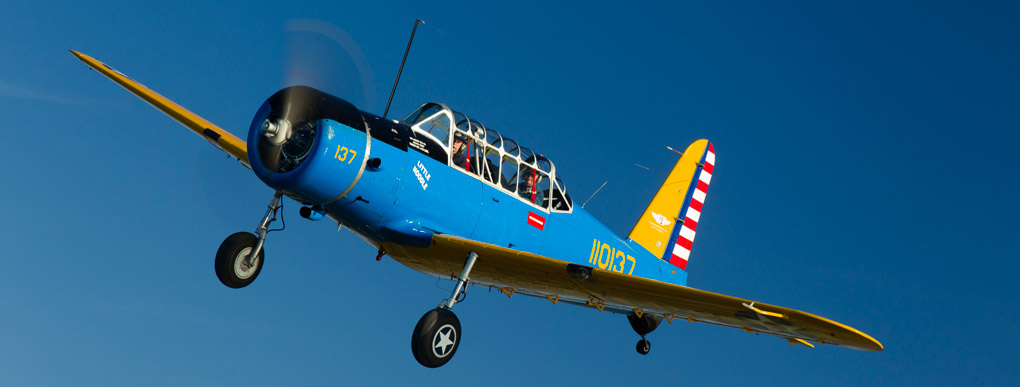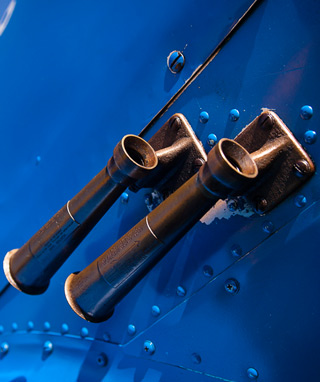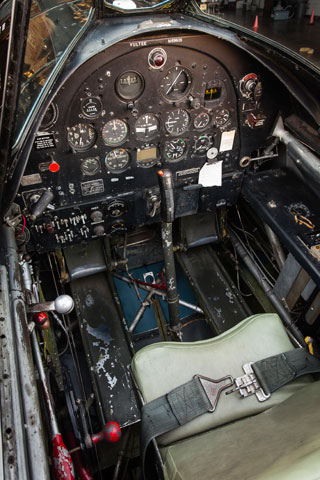
Photography by Mike Fizer
When seeing a Vultee BT–13 Valiant for first time, most pilots believe they’re looking at a North American AT–6 Texan because these aircraft look so similar. The astute observer will notice, however, that the BT–13 has fixed landing gear, while the T–6 has retractable gear. Another distinctive feature of the Valiant is the tall antenna mast mounted forward of its cockpit. The well-trained eye might notice, too, that the Vultee has a symmetrical airfoil; the T–6 does not.
During World War II, military student pilots received primary training and took their first lessons in any of several open-cockpit trainers: the Stearman PT–17 Kaydet, Ryan PT–22 Cadet, or Fairchild PT–19, –23, or –26 Cornell. They earned their wings after completing advanced training in the venerable AT–6.
Sandwiched between primary and advanced training were 10 weeks of basic training that invariably involved the Valiant. It was by far the most popular basic trainer of the war and provided basic training to the majority of military pilots. When you hear someone refer to the BT, they likely are talking about the BT–13.

The Valiant was manufactured by Vultee Aircraft in Downey, California. The company was named after Gerard “Jerry” Vultee, and the airplane was designed by Richard Palmer. It first flew in March 1939, and deliveries to the Army Air Corps began in June 1940. The Valiant was powered by a nine-cylinder, 450-horsepower Pratt & Whitney R-985 radial engine.
When the Connecticut engine maker could not keep up with demand, Vultee began to also use the Wright Whirlwind, the 440-horsepower version of the engine that propelled the Spirit of St. Louis to Paris. (The Whirlwind also powered some American tanks.) BT–13s powered by Wright radials are designated as BT–15s. Otherwise, the –13 and the –15 are virtually identical.
In 1944 when production halted, 11,538 BT–13s and –15s had been built. These included 1,800 SNVs, the Navy’s designation for the Valiant. This also is when military students began bypassing basic flight training and went directly from primary to advanced.
The aircraft featured on these pages, U.S. Army Air Corps No. 41-1037, is a Wright-powered BT–15 built in May 1941. It served at several California training bases until 1943, after which it had a number of civilian owners. It was donated to the Commemorative Air Force in 1979 and assigned to the CAF’s Dallas-Fort Worth Wing in 1989. It is based at the Lancaster Regional Airport in Lancaster, Texas, a farming community south of Dallas. N69605 flies in airshows and has the same high-visibility paint scheme used to identify student pilots during the war. The solid red circle within the insignia indicates that this is a pre-Pearl Harbor paint scheme; it was removed from U.S. aircraft after the Japanese attack to avoid possible confusion with the solid red “meatball” used on Japanese aircraft.
Before soloing a BT, a student had to sit blindfolded in the front cockpit and unhesitatingly place his hand on any of 33 controls and switches as his instructor called them out. The rear cockpit had a curtain that could be pulled forward to surround an instrument student and prevent him from seeing outside during “blind” flight training. (There were no portable instrument hoods in those days.)
Thankfully I did not have to endure the embarrassment of a blindfold test when being checked in the BT by Russ Coonley, a CAF instructor-pilot and retired airline captain (Continental Airlines and United Parcel Service).
The Valiant’s cockpit is slightly smaller and laid out similarly to that of a T–6. It has a conventional electric starter but many original BTs had inertia starters. These involved energizing a motor that spun a heavy flywheel to its maximum rpm. (The wheel also could be spun manually by a ground crewman using a crank when the battery was low.) The pilot then activated the mesh switch. This engaged the flywheel to the engine, and its inertia turned the engine. Hopefully, the engine started before the wheel’s inertia was dissipated, otherwise the process was repeated. (A video of a BT–13 starting inertially is available on YouTube. Search for “BT–13 Startup.”)
The engine should be started with the propeller in high pitch. After engine oil pressure increases, the prop control is moved forward. Engine oil pressurizes the propeller cylinder, which moves the blades into low pitch. This procedure ensures that the entire oil supply is available to the engine during start and that relatively warm oil is used to change propeller pitch.
The BT does not have an electric fuel pump. To create fuel pressure for starting, the pilot moves up and down a wobble-pump handle located to the left of his seat. If the engine-driven fuel pump fails during flight, the pilot must continually “wobble” the manual pump to keep the engine running until after landing. The BT–13 was equipped with built-in relief tubes. (That’s my kind of airplane.) Its “artificial horizons” and “directional gyros” are vacuum-driven by venturi tubes.
The Valiant has wet wings, each containing 60 gallons of fuel. Takeoff is made on the fullest tank, but when the right tank is selected, only 43 of its 60 gallons are usable. The bottom 17 gallons of the right tank is considered reserve fuel and can be used only by selecting Reserve with the fuel selector.
Taxiing with an open canopy on a warm day with the rumble of the radial engine’s exhaust is delightful. Forward visibility over the large nose, though, is poor, requiring S-turns on a straightaway to ensure that you don’t bump into something. The hydraulic brakes and main landing-gear wheels are the same as those on an AT–6.


The slotted flaps are extended using a hand crank between the seat and the left cockpit sidewall. Each full rotation of the crank lowers the flaps two degrees. The aircraft has a flap-position indicator, but some pilots prefer counting cranks. Setting 20 degrees for takeoff requires rotating the crank 10 times. Another way to set takeoff flaps is to move the control stick fully left and rotate the crank until the flaps are extended as much as the right aileron is deflected downward. Such “matching” is not recommended when airborne.
Takeoff is made with full throttle using 36 inches of supercharged manifold pressure and 2,250 rpm. The takeoff is noisy for bystanders because the propeller tips exceed the speed of sound. The BT leaves the ground at 70 mph and climbs best at 90.
Once established in the climb, pull the throttle back about an inch. Then pull the propeller-pitch control fully aft. The airplane has a two-position propeller, not a constant-speed propeller. It can be set only to a low pitch
of 12.5 degrees (for takeoff) or a high pitch of 18 degrees (for climb and cruise). There are no intermediate positions.
It was easy (for me, anyway) to inadvertently grab the mixture control and try bringing it fully aft after takeoff (instead of the adjacent prop control). Fortunately, the mixture control has a ratchet that prevents the airplane from becoming suddenly quiet. (The ratchet can be bypassed when needing to lean the mixture.)
After setting the prop to high pitch (low rpm), all subsequent power changes are made using throttle only. Set to low or high pitch, the propeller behaves as if it were a fixed-pitch propeller—which, in a sense, it is. Just like when flying with a fixed-pitch propeller, increasing airspeed increases rpm, while decreasing speed reduces rpm.
The flight controls are responsive and reasonably well harmonized, but the ailerons are a bit heavy even though equipped with servo tabs, a form of aerodynamic power steering, to reduce stick forces. The BT doesn’t seem to have any undesirable traits, but when stalled—even with the slip-skid ball caged—it falls off on a wing. Recovery, however, is easy and conventional.
The yellow band of the tachometer, 1,350 rpm to 1,650 rpm, should be avoided during an approach to landing. Otherwise, you quickly learn why the Valiant was affectionately called the Vultee “Vibrator.” Some claim that this nickname resulted from the BT’s tendency to shake violently as it approaches a stall, something I did not notice. Others say that the canopy vibrates during aggressive maneuvering. It has been said, too, that a BT takeoff causes windows on the ground to vibrate.
The airplane can be landed with 60 degrees of flaps, but this makes touch-and-go landings and missed approaches more difficult because of the enormous drag. Having to crank the handle to raise the flaps at such critical times can be challenging. Landing with 40 degrees is more practical. The Vibrator is a joy to land either on the mains or in three-point attitude.

By the end of 1948 there were 4,000 surplus BT–13s and –15s in civilian hands. There was one at almost every airport, but they were expensive to maintain. Many owners abandoned their aircraft after their engines had run out. Other BTs were purchased for their engines, and naked airframes were abandoned or scrapped.
Although there are now 300 registered with the FAA, only about 40 remain airworthy. A few BTs were modified to look like Japanese torpedo bombers and used in the motion pictures Tora! Tora! Tora! and Pearl Harbor. These aircraft also are used in battle reenactments at airshows.
The author dedicates this article to those thousands of airmen who trained in the Vultee Vibrator as they prepared to defend their country.

SPEC SHEET
Vultee BT–13 and BT–15 Valiant
Cost during World War II: $23,068
Postwar price: Approximately $500
Specifications
- Powerplant | BT–13 Pratt & Whitney R-985, 9-cylinder radial, 450 hp BT–15 Wright R-975 Whirlwind, 9-cylinder radial, 440 hp
- Recommended TBO | typically 1,500 to 1,800 hr
- Propeller | 2-blade, Hamilton Standard, 2-position
- Diameter | 108 in
- Length | 28 ft 10 in
- Height | 12 ft 4 in
- Wingspan | 42 ft
- Wing area | 239 sq ft
- Wing loading | 19.9 lb/sq ft
- Power loading | 10.5 lb/hp
- Dihedral | 7 deg
- Seats | 2
- Empty weight | 3,375 lb
- Empty weight, as tested | 3,560 lb
- Max gross weight | 4,745 lb
- Useful load | 1,370 lb
- Useful load, as tested | 1,185 lb
- Payload w/full fuel | 650 lb
- Payload w/full fuel, as tested | 465 lb
- Max takeoff weight | 4,745 lb
- Max landing weight | 4,745 lb
- Fuel capacity | 120 gal
- 720 lb
- Oil capacity | 10.9 gal
- Baggage capacity | 150 lb
Performance
- Takeoff distance, ground roll | 750 ft
- Takeoff distance over 50-ft obstacle | 1,400 ft
- Rate of climb, sea level | 1,050 fpm
- Max level speed, sea level | 183 mph
- Cruise speed/range (no reserve)
- (fuel consumption), 10,000 ft
- @ max. cont. power | 156 mph/340 sm
- (198 pph/33 gph)
- @ normal power | 146 mph/550 sm
- (162 pph/27 gph)
- @ max. range | 123 mph/790 sm
- (90 pph/15 gph)
- Service ceiling | 21,650 ft
- Landing distance over 50-ft obstacle | 1,300 ft
- Landing distance, ground roll | 650 ft
Limiting and Recommended Airspeeds
- VX (best angle of climb) | 80 mph
- VY (best rate of climb) | 90 mph
- VGLIDE | 90 mph
- VFE (max flap extended) | 120 mph
- VNE (never exceed) | 230 mph
- VLIFTOFF (rotation) | 70 mph
- VS1 (stall, clean) | 72 mph
- VSO (stall, in landing configuration) | 62 mph
All specifications are based on manufacturer’s calculations. All performance figures are based on standard day, standard atmosphere, sea level, gross weight conditions unless otherwise noted.



